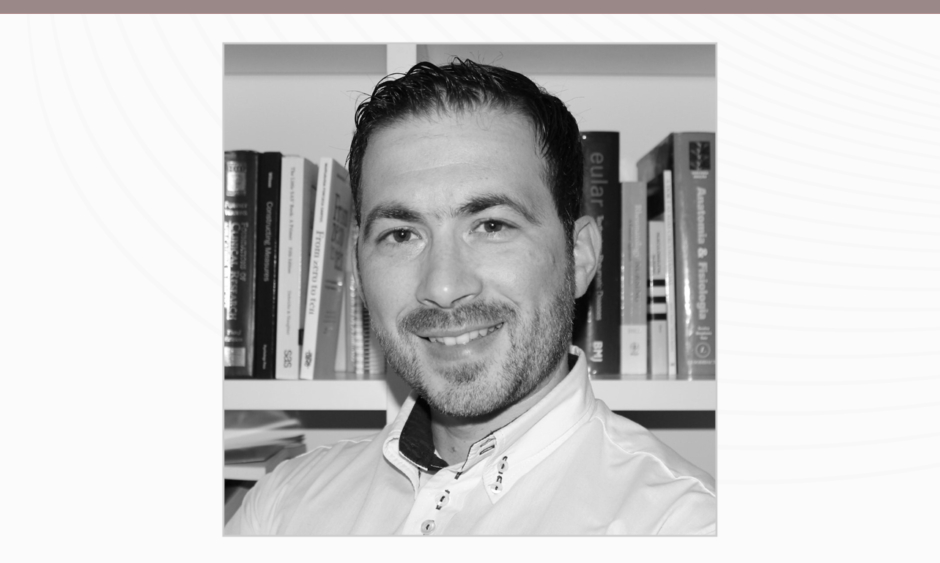Ricardo Ferreira | Chair of the EULAR Committee of Health Professionals in Rheumatology; Clinical Research Nurse and Study Coordinator, Rheumatology Department, Centro Hospitalar e Universitário de Coimbra,Portugal
![]()
You recently co-authored an article on treatment targets in rheumatoid arthritis. Could you please share any emerging evidence on the need to redefine such targets in patients with rheumatic diseases?
The dual-target strategy is still being developed and more research is needed, especially defining the second target’s assessment. As a reminder, this proposal aims at fostering person-centred care and reducing the burden of the disease by using two complementary targets: one focussed on the disease process (the biological target) and the other focussed on symptoms and impact (the impact target).1 We proposed that the Patient Global Assessment (PGA) of disease activity should not be included in the definition of the biological target but instead replaced by more meaningful measures included in a different target of equal importance. Several papers have presented compelling evidence to dropping out the PGA, but this has been the controversial part of the proposal. Our most recent publication shows that a high PGA in patients with rheumatoid arthritis otherwise in remission do not reflect subclinical inflammation.2 This result further supports that PGA is more a measure of symptom severity and disease impact than a true reflection of disease activity. We now need to obtain a broader consensus on how this may be applicable in clinical practice with the input of the different stakeholders. I do believe that this proposal will also prompt a better interdisciplinary collaboration in rheumatology.
As the Chair of the EULAR Health Professionals in Rheumatology (HPR) Representation Committee, could you explain what this position entails and how it contributes to the success of EULAR?
As Chair of the EULAR HPR committee, together with the Past-Chair or Chair-Elect, I am asked to initiate, drive, and manage the projects under the HPR committee umbrella. These projects include the educational offerings (e.g., online and face-to-face courses), scientific outputs (e.g., clinical practice recommendations), knowledge translation activities (e.g., assessment and promotion of implementation activities), or awareness and advocacy actions, desirably in close co-operation with other EULAR committees (e.g., PARE) or organisations (e.g., American Rheumatology Professionals). HPR is composed of three sub-committees (Educational, Scientific, and Knowledge Translation) and has a maximum of 25 members. The committee meets at least twice a year to discuss the interests and projects of the HPR as well as EULAR business.
The Chair of the committee, together with the HPR Vice-President, is also an inherent member of the scientific committee of the EULAR annual congress, which is another challenging but equally rewarding task. The contribution to the success of EULAR is also provided through the active participation and voting on the EULAR Council Meetings and smaller meetings with the other committee’s chairs, to bear our collective expertise as a ‘think tank’ for EULAR and to reflect on long term strategy.
You were appointed Chair of the EULAR HPR last year when academic learning and meetings were made virtual in response to the pandemic. What has been your proudest achievement over this past year?
Indeed, after being appointed as Chair I was only able to participate in one face-to-face meeting of our HPR committee (Lisbon, December 2019) and all other essential meetings, such as the annual congresses, went online. This could have affected the commitment and motivation of committee members, but that was not the case. We were able to adapt and improve in different ways. For instance, after postponing the first HPR post-graduate course, a 2-day interaction in Madrid course with language facilitation (Spanish and Portuguese) for the first day, we changed it into an online interactive course with great success. We implemented some innovative engagement strategies, such as clinical case discussions during the weekdays, in a forum per group, facilitated by mentors, in preparation for the synchronous sessions on Fridays, when the lectures and workshops took place. We had more than 150 applications, from different continents, and with many rheumatologists applying.3 We were also able to initiate new important projects, namely a task force to develop recommendations for the management of fatigue in people with inflammatory arthritis. However, some of the most important achievements, not only from this but from all committees, was the change in our internal organisation, which required new bylaws, changing the members. Being able to keep all HPR community engaged and active was a proud achievement, considering all the challenges we all have been through.
How have you developed the skills to perform your role as Chair of this committee? How do you monitor the performance of the organisation?
I have been able to participate actively in all these activities as Chair thanks to the outstanding support from my predecessor, Rikke Helene Moe, and the excellent collaboration we had with the HPR Vice-President, Thea Vliet Vlieland, with monthly meetings and uncountable emails and WhatsApp discussions. We can say that the Chair has a more operational role and the Vice-President more an organisational one, but we work very closely. My previous role as member of the HPR scientific sub-committee for 4 years, the participation in some EULAR task forces and study groups also helped me to develop my skills. I have also made some short educational visits to other rheumatology departments in the Netherlands and France, which allowed me to see how other healthcare systems, and particularly how rheumatology, can be organised, e.g., in terms of multi-disciplinary collaboration, educational, or preventive interventions.
One of my best competences, I believe, is the capacity to observe and liaise to others, and I have watched the way other Chairs manage their committees and took some important advice.
To monitor all the activities, I have the support from the EULAR secretariat, and all documents (including periodic follow-up reports) are stored in an internal cloud, which the Chairs can monitor at all times. But, more importantly, we have strengthened the communication and given more autonomy to the leaders of the three HPR sub-committees. They can have their own meetings and we also meet and communicate quite often.
What is one of the biggest challenges for the EULAR HPR in their goal to promote multidisciplinary collaboration in the treatment of rheumatic and musculoskeletal diseases in Europe?
EULAR involves, in all its initiatives, people from diverse background professions, different countries, sex balance, always patient representatives, and sometimes other stakeholders. However, despite this collaborative perspective when developing new products, for instance, clinical practice recommendations, their implementation is more difficult and depends a lot on the structure and organisation of countries’ healthcare systems. Unfortunately, most of the countries are still centred in a biomedical paradigm, where the physician and the pharmacological treatments are the central interventions. The success of the healthcare sector is measured by the number of medical consultations, surgeries, length of hospitalisation, and life-time expectancy. However, we all know that other outcomes are also essential, but not considered, such as quality of life, self-efficacy, work productivity (or healthy working years), among others. Healthcare systems who promote the multi-disciplinary teamwork from the onset of the disease process, and not only when drugs are not enough, have much better outcomes. We can look for instance to the Nordic countries and to the osteoarthritis management.
Another important challenge is to promote a balanced development for all the professions represented by this HPR committee, including nurses, physiotherapists, occupational therapists, psychologists, nutritionists, social workers, pharmacists, exercise scientists, among others. In different countries, these professions have specific competencies, educational and legal bases and to promote a European framework to the rheumatology speciality for each of these professions is a true challenge. We have addressed so far only the generic competences,4 but I believe that in a near future, EULAR HPR will need to liaise with European professional bodies to discuss this consensual speciality framework like the rheumatologists have.
How much of an impact do you believe the EULAR and EULAR HPR have on both rheumatologists and patients?
EULAR will celebrate its 75th anniversary in 2022 being worldly recognised organisation, which has been adapting through the years. The HPR Committee was officially formed in 1989, and has continuously evolving, having a third sub-committee created in the present year: the knowledge translation. In a similar way the ‘patient’s committee’ had a precursor organisation, the Social Leagues, in 1973, and formalised in 2008 as it is currently known: the PARE committee. Altogether, these EULAR communities made efforts to reduce the impact of rheumatic and musculoskeletal diseases (RMDs) on the individual and society and to improve the social position and the quality of life of people with RMDs in Europe. Naturally, not all health professionals are aware of the important documents and learning opportunities produced by EULAR. This is a very important role of the national associations of rheumatologists, HPR, and patients, to increase this awareness and to promote national capacity to improve RMD access and quality care. We all recognise that language is a barrier and different efforts have been made, such as translations of key messages and lay summaries, among others. Nevertheless, we have plenty examples on how the recommendations produced by EULAR, as well as the educational visits, courses, grants and other services have shaped the organisation of national departments and patient’s lives. We also believe that the involvement of ‘national champions’ in EULAR activities is key to prompt changes.
Based on your experiences, what advice do you have for rheumatologists in the early days of their careers?
My advice would be in investing time of their education on communication and empathy skills as these are essential in every clinical contact, but indispensable for caring people with chronic diseases. RMDs impact the patient’s lives in many ways and we all recognise that pharmacological treatments, despite impressive advances, are not enough to abrogate disease impact. This calls for the importance of a multidisciplinary integrated approach. Asking the support or collaboration from other team members, such as podiatrist, psychologist, nutritionist, occupational therapist, among others, is not a sign of incompetency. On the contrary, evidence states that addressing issues such as depressive symptoms or obesity from early diagnosis and pharmacological intervention will improve the clinical response in terms of disease activity, improving overall quality of life.








